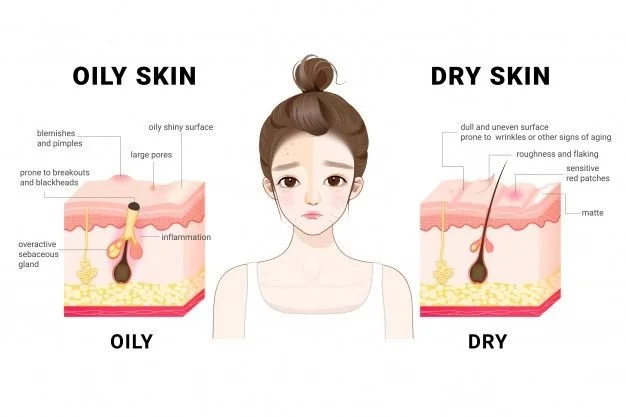Oily Skin: Why It Happens and How to Balance It
1. What Makes Skin “Oily”?
Oily skin is first and foremost a genetically determined skin type. Your sebaceous (oil) glands are programmed to produce more sebum than those of a normal‑ or dry‑skinned friend. Because each gland is larger and more active, the entire dermis is physically thicker than that of a dry skin type.
Good news! Even as collagen and elastin decline with time, an oily complexion still retains a measurable thickness advantage, so it generally wrinkles more slowly than drier, thinner skin.
2. The Down Side of Oily Skin
Make‑up “slides” off by midday
• Why: Fresh sebum dissolves foundations and primers.
• Tip: Opt for silicone‑based or long‑wear formulas and set with a lightweight, oil‑absorbing powder.Products feel heavy or greasy
• Why: Rich creams trap extra sebum at the surface.
• Tip: Choose gel‑cream or serum textures labelled “non‑comedogenic”.Frequent breakouts & enlarged pores
• Why: Excess sebum plus Cutibacterium acnes create clogged follicles (comedones).
• Tip: Use actives that keep pores clear and reduce oil output (see Section 5).
3. How Acne Develops in Oily Skin
Over‑production of sebum fills the follicle.
Dead keratinocytes stick together inside the pore, forming a plug.
Cutibacterium acnes thrives in this oxygen‑poor, lipid‑rich environment.
The immune system reacts → redness, swelling, and sometimes cyst formation.
Because step 1 starts with genetics, complete “cure” is unrealistic—but strategic skincare can rebalance oil flow, reduce inflammation, and speed healing.
4. Oily Skin Still Needs Hydration
Dehydration = lack of water, not oil. Stripping cleansers or skipping moisturiser causes the skin barrier to crack, which ironically triggers more sebum. A lightweight, humectant‑rich hydrator (eg glycerin or hyaluronic acid) keeps water inside without an occlusive, greasy feel.
5. Active Ingredients We Trust in Clinic
Oil‑soluble Vitamin C (tetrahexyldecyl ascorbate) — Penetrates through sebum to deliver strong antioxidant and brightening benefits without the sting of water‑based L‑ascorbic acid. Use: morning, under SPF.
Niacinamide (4–10 %) — Reduces sebaceous activity, refines pore appearance, calms redness. Use: AM or PM after cleansing.
Salicylic acid (0.5–2 %) — Oil‑loving beta‑hydroxy acid that clears pore linings and lightly exfoliates. Use: 2–3 × weekly or as a leave‑on serum.
Azelaic acid (10–15 %) — Antimicrobial, anti‑inflammatory, helps with post‑blemish pigmentation. Use: daily, can be layered with most actives.
Tretinoin (prescription‑only) — Normalises keratinisation and measurably reduces sebum output over time; also the gold‑standard anti‑ageing ingredient. Use: introduce gradually at night under medical guidance.
6. Personalised Plans at Fresh Aesthetics
Dr Jayne (advanced aesthetics) and Dr Brian (skin health) design integrated protocols so your complexion looks smooth and ages beautifully. Our digital skin analyser measures pore size, oil flow, and hydration to track progress objectively. Book an appointment and leave with a complimentary step‑by‑step, evidence‑based routine tailored to your skin.
7. Key Takeaways
Oily skin is genetic and structurally thicker, making it more wrinkle‑resistant.
Sebum surplus leads to make‑up slippage, shine, and a higher risk of acne.
Hydration is essential; choose weightless textures instead of skipping moisture.
Targeted actives—especially oil‑soluble vitamin C and prescription tretinoin—keep pores clear and oil levels in check.
Trust medical professionals to fine‑tune your regimen with diagnostic tools, not trial‑and‑error.
Ready to put science behind your glow? Visit Fresh Aesthetics in Portadown for your personalised oily‑skin consultation today.




